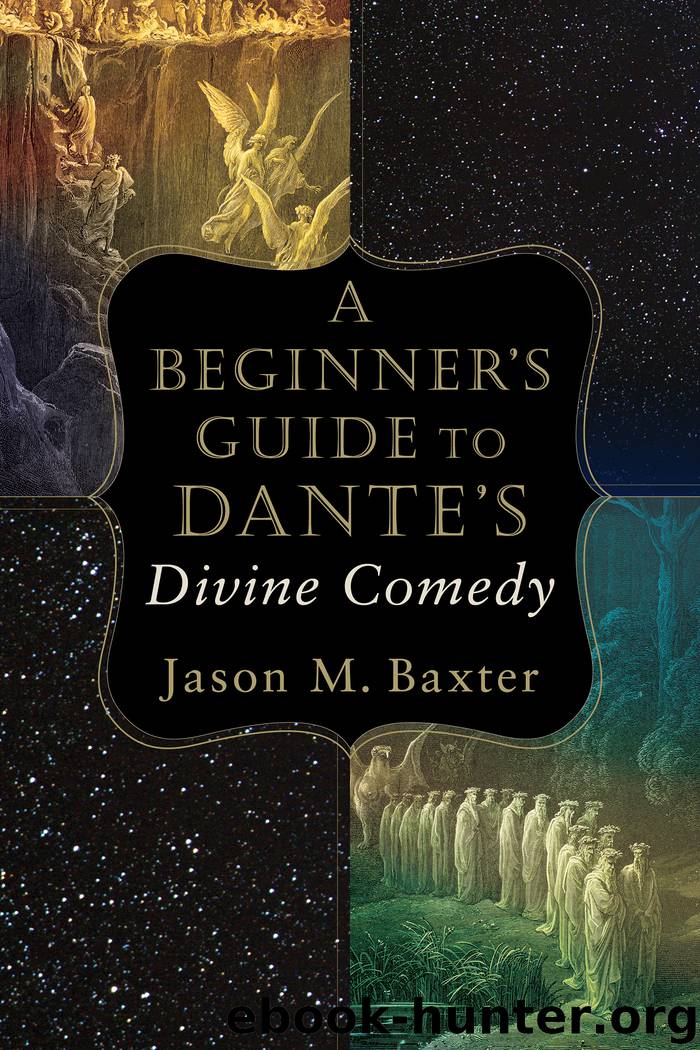A Beginner's Guide to Dante's Divine Comedy by Jason M. Baxter

Author:Jason M. Baxter
Language: eng
Format: epub
Tags: Literature/Education;Dante Alighieri (1265–1321) | Divina commedia | Criticism and interpretation;Christianity in literature;Religion and literature;REL013000;REL011000
ISBN: 9781493413102
Publisher: Baker Publishing Group
Published: 2018-01-11T05:00:00+00:00
8
In Search of Deep Cleansing: The Middle Canti
(Purgatorio 10–24)
At the Center of the Universe: Love and Freedom
As Dante will explain in canto 17, purgatory, just like hell, has its own elaborate moral architecture. In Inferno 11, Virgil and Dante came to a halt while they waited for their senses to get adjusted to the stench of hell. There the Roman poet described hell as divided into three major realms: the incontinent, the violent, and the fraudulent. In Purgatorio 17, Virgil explains the architecture of purgatory, and every detail of the design is related to love (Purg. 17.103–5). We can misdirect our inherent love by loving with too little force; we can love lower goods too much, trying to put them to uses they were not intended for; or our self-love can grow to the point that it is out of control, so that it becomes fear that our neighbor will deprive us of the good we long for (17.94–117). In hell the architecture is indebted to a classical way of thinking about good and evil (explicitly borrowed from Aristotle), but in Purgatorio Dante uses the seven terraces to embody the Christian monastic tradition of the seven deadly sins.1 And yet, at the same time, Dante creatively rethinks the seven deadly sins in order to bring them into harmony with the classical structure: lust, gluttony, and avarice are treated as dispositions that correspond to the incontinent sins of upper hell; sloth and wrath (the misuse of the irascible appetites) are linked to the circle of the violent in hell; while pride and envy are treated as faulty dispositions of the intellect, equivalent to sinful use of the intellect among the fraudulent in hell.2
Virgil’s speech on how love comes right at the center of the cosmos happens to be at the center of the Comedy: the fifty-first canto—that is, the first canto of the second half. Meanwhile, Purgatorio 16, Marco Lombardo’s speech on freedom, could be considered the last canto of the first half of the Comedy. Thus, these canti, which literally lie at the heart of the Comedy as a whole, together form a kind of diptych: love and the free response to love are at the heart of the universe. We have a love that irrupts, rushes into, invades, and courses through the world, enticing and persuading human beings to use their freedom to respond to it. This is the drama of human existence.
It is in light of this passionate vision of love—seeking an entry point into the human heart—that we will now turn to the middle canti of Purgatorio, which deal with the seven terraces of purgatory, and how the souls here correct their sinful disposition in an attempt to regain the power to respond to love.
Download
This site does not store any files on its server. We only index and link to content provided by other sites. Please contact the content providers to delete copyright contents if any and email us, we'll remove relevant links or contents immediately.
Habits of Grace by David Mathis(1898)
Anxious for Nothing by Max Lucado(1780)
A Prophet with Honor by William C. Martin(1649)
Peace with God by Billy Graham(1620)
Long Bright River by Liz Moore(1526)
Whisper by Mark Batterson(1387)
Expectation by Anna Hope(1368)
The Wondrous Workings of Planet Earth by Rachel Ignotofsky(1234)
Fortitude by Dan Crenshaw(1142)
Taste and See by Margaret Feinberg(1081)
Answers Book for Kids, Volume 3 by Ken Ham & Cindy Malott(1063)
I Declare War by Levi Lusko(1043)
Your Story Matters by Leslie Leyland Fields(1035)
Everybody, Always by Bob Goff(1033)
ST01 by Unknown Author(1021)
If by Mark Batterson(1021)
The Case for Miracles by Lee Strobel(996)
Power for Living by T. D. Jakes(995)
The Alpha by Unknown(988)
